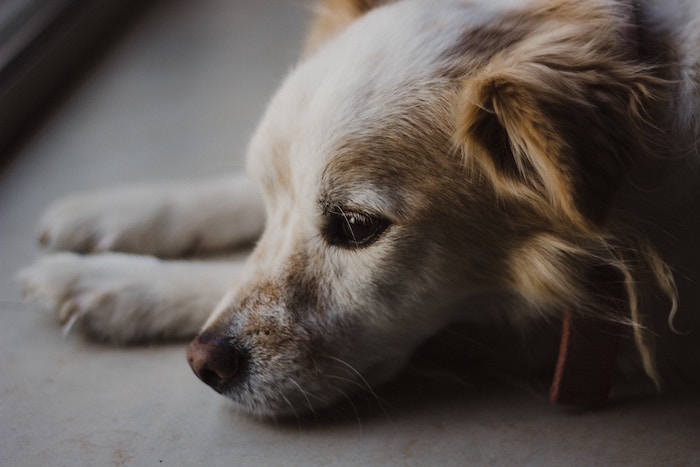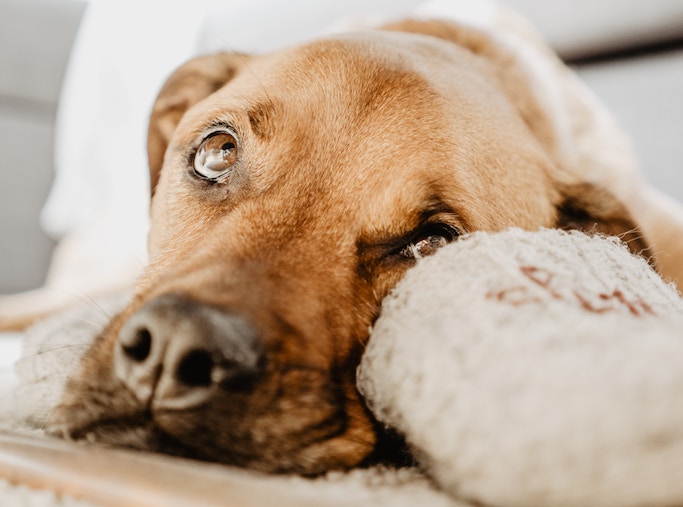Separation anxiety refers to the stress, fear and phobias that some dogs experience when separated from their owner.
If your dog has a history of abandonment or neglect or has been regularly re-homed, they’re likely to experience more severe separation anxiety, but it can be common among dogs of any upbringing.
Fortunately, it is a predominantly treatable condition that can be alleviated with patience and careful training. You can find out more about the causes and treatments for separation anxiety below.
What Does Separation Anxiety Present As?
Separation anxiety is experienced along a spectrum, ranging from mild to severe. A mildly anxious dog may present as trembling, with a tucked tail. They’ll typically be less active and may withdraw and hide.
At it’s most severe, it can result in dangerous or destructive behaviours like chewing, digging, wrecking property, barking, howling or urinating uncontrollably. Prolonged anxiety will affect your dog’s sympathetic autonomic nervous system and can be detrimental to their overall health and wellbeing.
It’s important to recognise the difference between true separation anxiety and simulated separation anxiety. The latter is actually a learned behaviour. It manifests when a dog knows that enacting the behaviour will attract attention. This typically manifests when the dog lacks sufficient self-control and confidence, and can even be due to boredom or lack of exercise. Because of this, the simulated response can be actively trained out of them. This is done by replacing associations of anxiety = attention, with more positive habits and behaviours.
What Causes Separation Anxiety?
If your dog has been re-homed multiple times or has experienced neglect at the hands of former owners, separation anxiety will often be an ingrained response to being left alone. However, your pet doesn’t have to have experienced any mistreatment to present with the associated symptoms. In fact, separation anxiety can often inadvertently occur because of how we interact with our dogs while with them, especially when they are younger.
Making unnecessary fuss when leaving or coming home will often condition our pets to experience stress when we depart, while constant socialisation and no concentrated, controlled time apart will increase their wariness of any separation in the future. Abrupt or repeated changes in routine will often induce these symptoms too, which is why it’s really important to consider separation anxiety if you are going on holidays without your dog OR taking them with you, but leaving them alone for long periods in unfamiliar accommodation environments.
How Can You Alleviate Separation Anxiety?
Separation anxiety, particularly the simulated variety, can be resolved through careful training, patience and consistent reward when your dog exhibits self-control and confidence when left alone for short or long periods of time.
This is where obedience training comes in; letting your dog know what is expected of them and what behaviours should be associated with positive reinforcement and attention. Teaching dogs to be quiet and settled is important in ensuring that they do not require constant stimulation and attention to feel calm and content. This is most easily achieved from when they are puppies, but if you’re beginning training later in life, don’t despair!
Use many different scenarios as opportunities for training. Have them sit in one room while you depart to another, for longer and longer periods. Encourage them to stay still while you move around a room, or when guests arrive at your house.
The following is a great example strategy from Dr Emily Blackwell of the RSPCA:
- Encourage your dog to go to their bed and stay there with you present for a short while. Reward them for remaining quietly in the bed.
- Ask your dog to stay in their bed as you move away, then return and reward.
- Move progressively further away for longer. The distance/time that you increase by on each occasion will depend on your dog. If your dog reacts or moves then don’t reward but go back to the previous stage.
- Start going out through the door before returning, then going out and shutting the door, then going out for longer periods of time, varying the length each time.
Separation anxiety training should be centred on positively reinforcing behaviours that exhibit self-confidence and control. It should always be approached incrementally and you can employ the use of anxiety-easing medications on advice from your vet. As with any sort of training, patience and consistency are key.
If your pet has suffered from separation anxiety, we’d love to hear about your experience and any tips and tricks you’ve used to alleviate it. Feel free to comment below.



My Australian Terrier is very attached to me and even when others were home he would sit looking out the front window waiting for me to come home. When I return he always brings me a shoe!!
The best solution was to get him a buddy who would always be home with him. So we contacted the breeder who happened to have a female puppy available who is also his full sibling, only two years younger.
They adore each other and are always cuddled up together, when they’re not chasing each other around! I strongly believe two dogs are better than one, and no matter how much time we play with them, nothing is as good for them as when they play with each other
I agree with what Shelley says about two dogs being better than one, but we live in a retirement village that allowed us to bring our two Jack Russells in but they are not allowed to be replaced. Sadly, our 16 yo little girl left us in May and the 11yo boy has become very clingy, now that he doesn’t have her for company. He has started howling when we are downstairs in the garden or the garage, even though he is taken out several times a day and goes on two walks daily. This will soon become a problem as new, maybe less tolerant neighbours move into the complex. Presently, he is loved by all and can do no wrong. I’m finding it difficult to put your tips into practice as he won’t leave our sides.